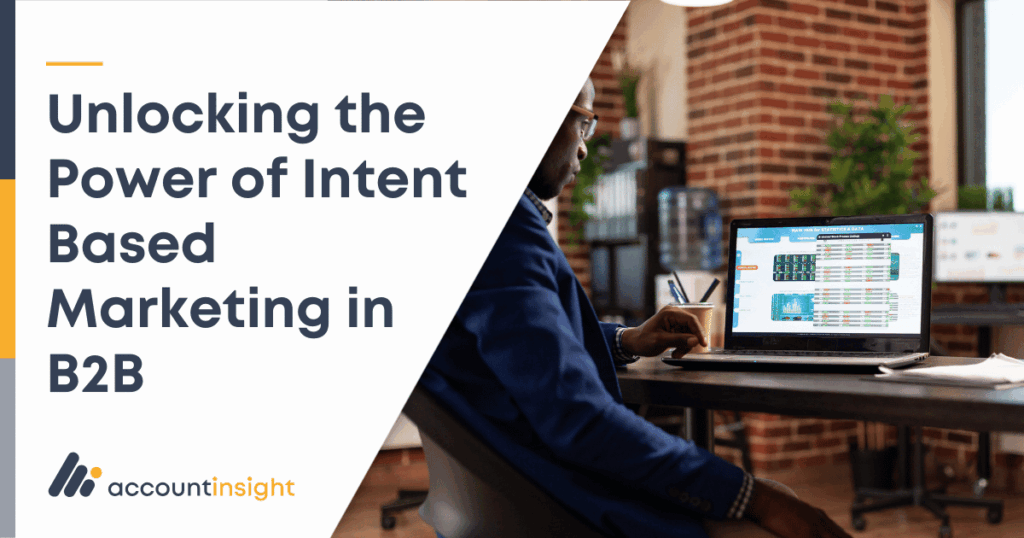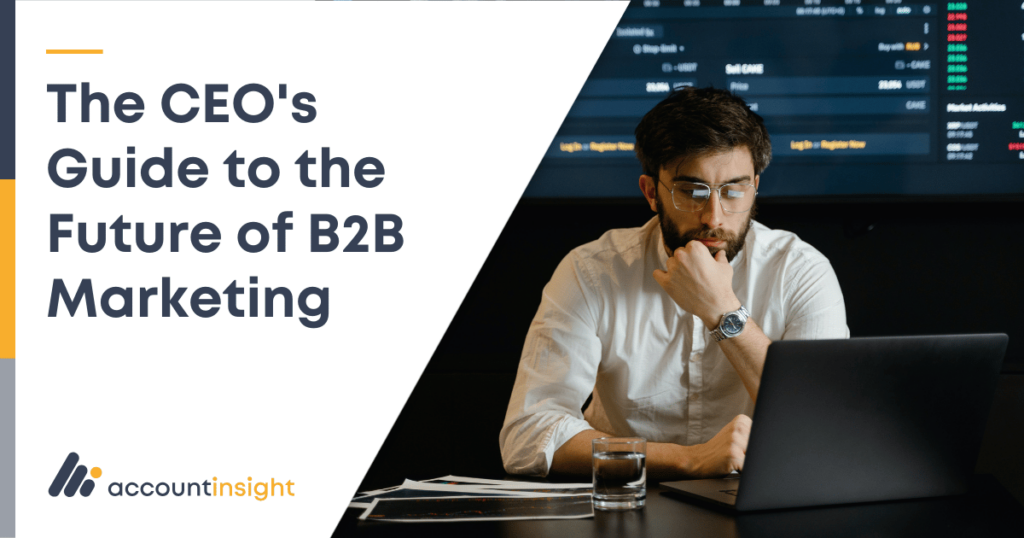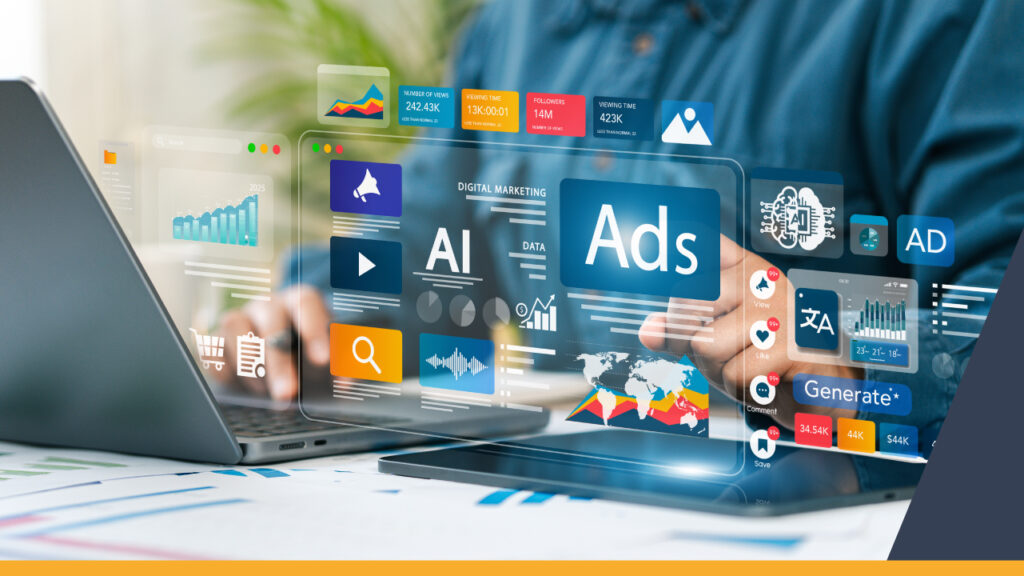The B2B market is becoming fiercely competitive, but creative brands know how to stay ahead. Some emerging trends in B2B marketing are giving service- and subscription-based brands – such as restaurant marketing or industry-specific technology providers – opportunities to connect with their target clients, build trust, and personalize the buying experience.
These are the trends that are poised to dominate in 2026 for B2B marketing – and likely to grow in coming years. Check out these trends and gain some guidance on how you can apply them to your own strategy.
Foundational Technology & AI Trends
AI tools and technology are providing virtually limitless opportunities to streamline workloads, especially for B2B brands.
1. AI-Powered Content Creation
Generative AI tools like ChatGPT, Jasper, and Copy.ai are transforming how brands plan and create content. These platforms allow teams to scale blog posts, emails, and social media content much faster than manual methods, freeing creative resources for strategy and innovation.
We’re likely to see a surge in AI content creation in 2026 with companies embedding AI directly into their content management systems (CMS) and customer data platforms (CDPs) to tailor messaging across every touchpoint – streamlining the process while creating more valuable experiences for clients.
2. Simplified Marketing Automation
Low-code and no-code automation platforms are democratizing marketing workflows. Tools like HubSpot, Zapier, and Make allow smaller teams with limited resources to implement complex lead nurturing, scoring, and CRM integration without the need for heavy IT support or outsourced workloads.
With AI becoming more and more accessible, we can expect automation to extend beyond emails into tasks like personalize landing pages, predictive lead scoring, and triggered workflows at different stages of the funnel. This trend can be a boon for brands looking to personalize at scale using real-time insights from buyer behavior.
3. AI-Enhanced PPC Campaigns
AI is already having an impact on pay-per-click advertising (PPC). Google Ads, Meta, and other platforms are leveraging machine learning to optimize bidding strategies, ad placements, and audience segmentation.
In 2026, these platforms are also integrating predictive analytics to anticipate campaign outcome and deliver recommendations before a campaign even launches. B2B companies already embracing AI-enhanced PPC tools are already seeing improved ROI, lower customer acquisition costs, and better alignment between ad creative and buyer intent.
4. Chatbot Expansion for B2B
AI-powered chatbots were one of the early implementations of AI technology, but it was primarily in the B2C market. B2B companies are increasingly using bots on their website and apps to qualify leads, answer frequently asked questions, schedule demos, and solve minor client concerns.
The benefit of chatbots for B2B is that they reduce friction in the buyer journey and provide instant, data-driven responses to complex inquiries. These bots are also integrated into CRM systems to provide advanced capabilities like internal sales support or cross-team collaboration.
Content Formats Gaining Momentum
B2B audiences are consuming and engaging with content differently, leading to a rise of different content formats that can be leveraged by B2B brands.
5. Video Marketing Dominance
Video continues to be the highest-performing content format for B2B. Explainer videos, product demos, customer testimonials, and behind-the-scenes clips foster trust and improve conversion rates by giving the client the information they need to make informed, confident decisions.
In addition, interactive videos and AI-generated voiceovers are finding their way into more B2B campaigns. YouTube, LinkedIn, and even TikTok are seeing increased B2B adoption, especially with mobile-first buyers that are seeking out educational – but visually engaging – content.
6. Podcasts as a B2B Channel
Podcasts are becoming powerful tools for thought leadership and niche audience engagement. Launching branded podcasts and sponsoring industry-relevant shows help B2B brands build authority and stay top-of-mind during long buying cycles.
These podcasts can be repurposed into blogs, audiograms, and short clips, getting brands more value out of their initial investment. And as voice search and smart speakers become more commonplace, strategies optimized for audio will complement visual and written content formats.
7. Bite-Sized, Short-Form Content
Short-form content tailored for social and mobile-first platforms is gaining traction. B2B brands are increasingly using infographics, carousels, short-form video, and animated explainer clips to deliver information to audiences quickly and appeal to the short attention span of modern audiences. These formats are especially effective in retargeting campaigns and email newsletters, which require clarity in a snappy message.
Personalization and Buyer-Centric Experiences
Modern B2B buyers demand customized, seamless experiences that are tailored to their unique needs and behaviors.
8. Hyper-Personalized Campaigns at Scale
It’s important for B2B brands to deliver campaigns that are tailored to each account or individual decision-makers that are part of the buying cycle. Leveraging real-time data, firmographics, and behavioral analytics with account-based marketing (ABM) platforms can make hyper-personalization more efficient and data driven, delivering content that automatically updates based on user behavior, geolocation, and company data.
9. Focus on ABM
ABM is likely to gain more momentum moving forward. B2B brands have been recognizing its effectiveness in targeting specific high-value accounts. It’s likely that more brands will invest in ABM and incorporate it into the marketing strategy with initiatives like coordinated sales and marketing efforts, personalized landing pages, and more. ABM enables focused, efficient resource allocation, a considerable advantage when brands are looking to do more with less, and can improve engagement and the speed of the sales cycle.
10. Persona-Driven Targeting
Developing detailed buyer personas is essential in 2026. These personas are more than a job title or income level and include decision-making style, digital behavior, pain points, and preferred content formats. B2B brands can leverage intent data from platforms like Demandbase and Bombora to refine segmentation and improve message resonance. Accurate personas can help teams align the content to the buyer, tailor outreach strategies, and develop more targeted sales enablement materials.
11. Seamless Multichannel Experiences
Like B2C buyers, B2B buyers move across websites, email, webinars, events, social platforms, and in-person experiences. It’s crucial to create consistent messaging, design, and experiences across all channels to build trust and reduce drop-off throughout the funnel.
Integrated tools and unified CRMs are key factors that we expect to see more of in 2026, particularly between sales, marketing, and customer success tools that can create a frictionless journey from early lead to loyal long-term client.
Competitive Content Strategy Trends
The marketplace is more saturated, so B2B brands must create smarter, more authoritative content strategies that are memorable and impactful.
12. Increased Content Competition
The volume of B2B content – and buyer expectations – continue to rise. It’s becoming harder and harder to stand out with quality, originality, and depth. B2B brands are investing more in editorial excellences, in-depth guides, and contributions from subject matter experts to provide real value. AI can help with finding gaps and trending topics, but it takes a human eye to ensure brands come across as authentic and credible.
13. Authoritative Content: Case Studies & Reports
Buyers want proof, not just promises. Case studies, industry reports, and original research are driving engagement and trust. Data-backed storytelling that demonstrates results and expertise are becoming a staple for B2B brands, such as reports that include proprietary research or benchmarks that are effective for building backlinks or media coverage.
14. Strategic Content Repurposing
Content creation and production is expensive. To maximize ROI, B2B brands are splicing and repurposing high-value assets like whitepapers and case studies into Reels, Shorts, social media posts, and email campaigns. This strategy allows consistent publishing without an extra burden on teams, especially with the help of AI tools that can edit content into tailored, platform-specific content at scale.
Creative and Differentiated Storytelling
B2B brands are exploring storytelling, interactivity, and immersive content like B2C brands to connect with clients on a deeper level.
15. Interactive Content Formats
Interactive tools like ROI calculators, assessments, and quizzes can boost engagement and dwell time. These formats encourage active participation instead of passive reading or viewing and generate more qualified leads with rich user data. Brands are also investing in advanced tools like gamified learning modules and virtual product walkthroughs that can add to the marketing efforts.
16. Brand Storytelling in Campaigns
Humanizing a brand through emotional storytelling is not just for B2C brands. B2B brands are weaving narratives around customer success, founder journeys, and mission-driven impact to make their campaigns more relatable for the audience.
17. Innovative Visual and AR/VR Formats
Visual storytelling is elevated through augmented and virtual reality experiences like 3D product demos and immersive walkthroughs of trade show booths. These creative approaches can help B2B brands stand out and communicate their complex value propositions in clear, approachable ways.
Channel and Platform Shifts
Platform usage and distribution strategies are experiencing a shift as B2B brands look to meet buyers where they are most active.
18. LinkedIn’s B2B Comeback
LinkedIn is growing in popularity once again, particularly as a go-to platform for B2B engagement. With improved ad targeting, robust analytics, and new formats like LinkedIn Live and newsletters, it’s becoming a hub of lead generation and content generation. Brands are investing more in employee advocacy programs and influencer collaborations to expand reach more organically.
19. Global and Multilingual Content Strategy
As B2B companies expand into global markets, localization becomes a vital consideration. Multilingual SEO, regional social strategies, and culturally adapted content ensure relevance and resonance across diverse markets, helping B2B brands penetrate more effectively. Tools like Weglot and Lokalise help streamline translation while AI is tailoring content to become more culturally aware.
Trust, Transparency & Ethics
Data regulations are becoming more restrictive – while social awareness is growing – and B2B brands are stepping up their transparency, integrity, and responsibility.
20. Sustainability and Ethical Marketing
Corporate social responsibility (CSR) is influencing B2B purchasing decisions. Buyers are seeking partners who align with their values, not just the best prices. Sustainability reporting, ethical sourcing, and inclusivity in messaging are becoming important value propositions.
21. Data Privacy and Responsible AI Use
With stricter global regulations and growing data literacy, B2B brands have to prioritize data transparency. Ethical AI usage, consent-driven data collection, and clear privacy policies build long-term trust with clients, and compliance is shifting from a legal “box check” to a pillar of a brand’s reputation.
Stay Ahead of B2B Marketing Trends
2026 is poised to be more competitive than ever. B2B brands need to embrace innovation, stay buyer-centric, and build trust through transparency, ethical practices, and enhanced experiences with an agile marketing strategy that fuels growth and long-term value.
Frequently Asked Questions About B2B Marketing Trends
How Do I Keep Up with Fast-Changing B2B Trends?
Trends can come and go quickly in digital marketing. B2B brands need to stay ahead by engaging in peer communities, attending industry events, and subscribing to trusted marketing newsletters. Platforms like LinkedIn, HubSpot, and MarketingProfs offer curated insights and research to identify relevant trends.
Why Are Events and Conferences Still Relevant?
Despite the rise of richer digital experiences, face-to-face interactions foster deep trust and accelerate sales cycles – especially in the unique brand-client relationship with B2B. Hybrid events can offer a flexible option while still delivering value, and content can be used for post-event nurturing and lead generation.
What Analytics Tools Help Track Market Shifts?
Google Analytics, HubSpot, SEMrush, and Tableau are popular tools that can provide insights into campaign performance, emerging trends, and areas for improvement. Another option is a platform like TrustRadius that provides intent data based on buyer research behavior.
How Important Is Monitoring Competitors?
Competitive analysis is essential to reveal gaps, benchmarks, and opportunities. Tools like BuzzSumo, Similarweb, and Crayon can keep brands informed about the competitive market and engagement trends to prepare for a pivot.
Does Upskilling Really Impact Marketing Results?
Yes. As technology evolves, B2B teams that continually develop their skills can better leverage tools, improve targeting, and drive ROI. Certifications in areas like SEO, marketing automation, and data analytics are exceptionally valuable in the coming year.
What’s the Role of Customer Feedback in B2B Growth?
Customer feedback shapes product development, content strategy, and service improvements. Tools like Hotjar, Typeform, and UserVoice can help collect insights to inform decision-making, reduce churn, and improve loyalty.
Author Bio: Chris Bretschger, Managing Partner at Bastion Agency, is a seasoned marketer with over 20 years of experience in integrated marketing. He has developed brand strategies, managed media campaigns, and built analytics tools for clients like Mazda, Adidas, Jenny Craig, and Kia. When not leading Bastion, Chris enjoys superyacht regatta racing on the open seas.







